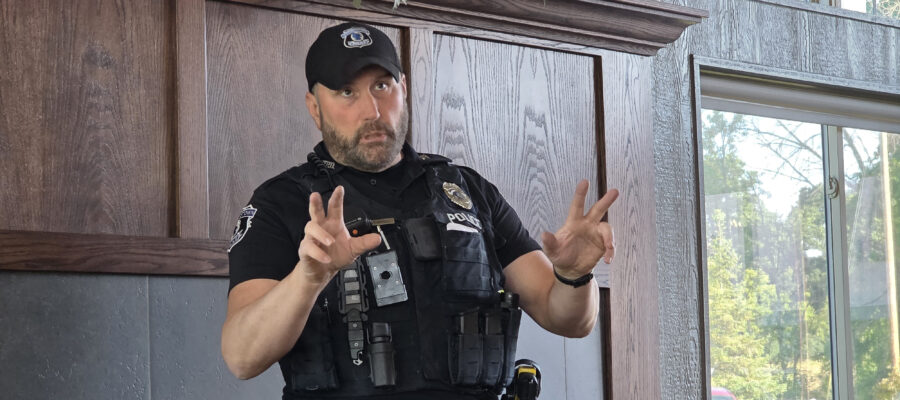Brian Roebke photo
Officer Gary DeWinter spoke about police pursuits last week at Coffee with a Cop, held by the Wrightstown Police Department, with sponsorship by the Wrightstown Area Business and Community Alliance.
By Brian Roebke
Editor
Officer Gary DeWinter was the guest speaker at this month’s Coffee with a Cop at The River Coffee & Cream in Wrightstown, talking about police pursuits.
They’re not as exciting as they would seem to the common person, DeWinter told the group gathered for the Wrightstown Police Depart-ment’s monthly event.
“Pursuits are very dangerous,” DeWinter said.
Pursuits start with a traffic stop where the officer attempts to stop the vehicle. Sometimes, the vehicle stops and other times they just keep going.
Only rarely does the driver of the vehicle being pursued get away with it. The only chance would be if neither the officer, other vehicles, or security cameras get a good look at the vehicle and the license plate and police give up the chase because of safety reasons.
Most of the time, however, law enforcement gets the plate number and the driver is eventually tracked down.
Vehicles can be pulled over for a routine traffic stop, the officer gets out of the car, and the person takes off.
At that point, it’s a crime and it’s a felony before the pursuit even begins.
“Sometimes people don’t even drive off to the side,” DeWinter said. “As soon as they see the lights, they’re taking off.”
Years ago, DeWinter said, police officers used to pursue for anything and everything but nowadays, it’s less frequent because of department policies.
“With all the liability out there, they pretty much pick and choose what they’re going to chase,” he said.
More departments in Brown County do not chase any more. Wrightstown and De Pere will, under the right circumstances.
“Some around here, it’s got to be a felony, it’s got to be an immediate danger to the public, other officers, and then other departments if it’s just a traffic stop and they take off and a person just doesn’t have a license, they’re going to chase you down until it stops,” he said.
He noted Fond du Lac and Shawano will pursue for anything and everything until the vehicle can’t go any further.
“In Wrightstown we actually have a pursuit policy and what we are allowed to pursue,” DeWinter said.
Most pursuits are held past midnight, with the only “good” thing being a lot less traffic on the roads.
DeWinter was involved in his 13th pursuit in his 12 ½-year career this summer while doing special enforcement in the City of Green Bay. Ironically, his 12th was the night prior to that.
“They’re dangerous, but the way we look at it is if somebody is fleeing an officer, there’s a reason why,” he said.
DeWinter noted most drivers know if it’s a minor offense, they’re going to get a ticket and not end up in jail.
He said there are differences in opinions in the law enforcement community about pursuits, but Wrightstown is coming after you.
He noted the “bad guys” sometimes know what department policies are and they try to take advantage of that.
“As a law enforcement officer I am all for them because there’s a reason why people are fleeing,” DeWinter said.
Backup from Brown or Outagamie counties is initiated immediately after the Wrightstown officer radios dispatch telling them of the pursuit.
In his most recent pursuit, it started downtown Green Bay and ended in De Pere, with Green Bay, Brown County and De Pere assisting.
“As an officer when you’re in a pursuit, there are many things that are going on inside that car,” DeWinter said.
In the usual case, he’s in the vehicle by himself, driving and calling into dispatch at the same time. During his last one, Officer Heather Martin was with him and she did the talking.
While he’s in pursuit, he’s on the police radio informing everyone of where he’s traveling, and what the driver is doing, so others can come to help.
While this is happening, everything’s being documented for police records and determining charges. Speeds are often more than 100 miles per hour.
Pursuits can be terminated when drivers turn the lights off on the vehicle and the situation gets real dangerous, particularly in residential areas.
“When people are in those pursuits, most of them, 98 percent of them, can’t drive like we can drive in that situation,” DeWinter said, noting officers are trained in high-speed driving conditions.
If law enforcement is doing a PIT maneuver on a vehicle, usually their vehicles don’t get damaged.
What’s a PIT maneuver? It’s when the officer uses a “precision intervention technique” and comes up on their back bumper and veers to the left or right quarter panel. “My front only has to touch their rear on the side and I can spin them right out and I just keep going straight and they’re spun,” DeWinter said.
PIT maneuvers can’t be done at extreme speeds, however.
All police vehicles now have road spikes in their trunks, but drivers are getting smarter by learning how to drive around them.
What happens when people who flee officers appear in court? “The judges don’t tolerate that, not at all,” DeWinter said.
When asked how many of his 13 pursuits would have been just a misdemeanor if they had stopped, DeWinter said all of them.
He said some of them wouldn’t even have been misdemeanors but traffic forfeitures.
Most stops are for driving without a license, which is a $130 fine.
The worst part of it for the driver is the officer knows who they are, and they’re not going to get off the hook. They’re just in deeper trouble.

